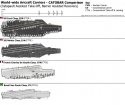and
are investing heavily in cyber and electronic warfare, but they’re not
US
yet. Instead, we have met the enemy and he is us — we think.
“In 2015 thus far, we have had 261 cases where we have been jammed from getting information from our satellites down to the ground segment,” said
head of Air Force Space Command, at the
electronic warfare conference.
That’s 23 times a month. “How many were caused by an adversary?” Hyten asked. “I really don’t know. My guess is zero.”
The real cause is “almost always self-jamming” where our own transmissions, radar or radio, unwittingly interfere, Hyten told reporters after his public remarks.
“The moral of that story is the
is unbelievably complicated and the smallest mistake can create huge strategic impacts,” Hyten said, “so you have to be able to monitor the electromagnetic spectrum, from the most tactical unit all the way up to the most strategic [level].”
Self-jamming shows we don’t have enough awareness of what our
own forces are doing in the spectrum, let alone of what an adversary might do, Hyten said. “We have not had a focus on it,” he admitted, but the military is now working to build that awareness.
“We’ve just been assuming that the RF [radio frequency] spectrum is a benign environment and nobody’s going to threaten us,” Hyten told the AOC gathering. But as the US military has made ever more spectacular use of satellites and networks, he said, “The rest of the world’s been watching that too — China and Russia in particular.”
The most spectacular result was
that filled orbital pathways with debris, said Hyten, but “you don’t have to shoot a satellite down to defeat it, all you have to do is cut off the link.”
“We have to be able to effectively operate in this contested, congested environment,” Hyten continued. “We’ve got to be able to fight in it and defeat any adversary that’s in there….but if we don’t train our airmen fundamentally differently to operate in this environment, we can’t do that.”
There’s a whole generation of cyber-savvy digital natives that can run electronic circles around their elders — but they’ve never had to operate with the network off.
“They haven’t had to deal with spectrum threats, they haven’t had to deal with an electronic warfare environment,” said Hyten. “I’m probably one of the last people in my command that was around when we had to deal with the Soviet threat that was there in the 1980s. We knew how to do that and somehow we forgot.”
One way Air Force Space Command is seeking to adapt is by putting its most experienced operators back at the console operating satellites. While aircraft pilots keep flying as long as they can, Hyten said, space career paths tend to promote veterans to staff jobs while leaving day-to-day operations in the hands of new recruits.
“The average age of the operator operating GPS today is 23,” he said. “Two 19-year-old airmen are the two guys that [were] flying GPS this morning — for the entire world. It’s amazing! — and it’s wrong, because we need to have the most experienced guys on that crew force.”
So AFSPC is dissolving its “day staff” and using those personnel to double the size of the “crew force” actually running the satellites. “It used to be the day staff was actually larger than the crew force,” Hyten told reporters. “[Now] everybody that was on day staff is going back on crew and they’re going back on operational positions.”
“So now you’re going to have no day staff but you’re going to have two crew forces,” Hyten continued. At any given time, one crew force will be running
, while the other will doing “high-end training.” Every four months, they’ll switch, with the first such handover happening next spring. After enough cycles, Hyten said, Air Force Space Command will have highly trained, experienced crews capable of operating the satellites in the face of sophisticated and intense attack.
This initiative is separate from the new “
,” as Hyten described the
, whose future status remains uncertain. Through May, JICSPOC will work intensively on developing new ways of combatting future threats. Whether it will become a permanent feature of Air Force Space Command he can’t say, but “nine months from now when you ask that question, we’ll have a different answer.”


